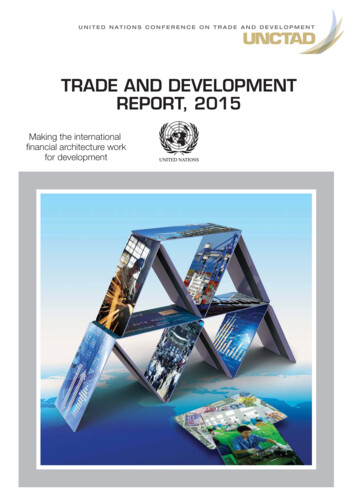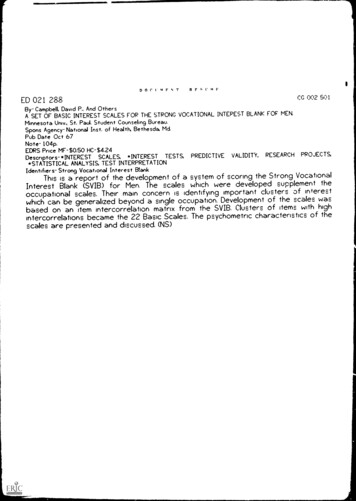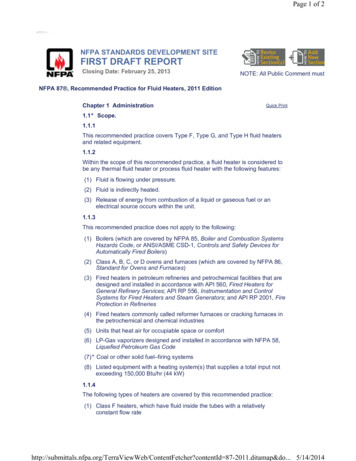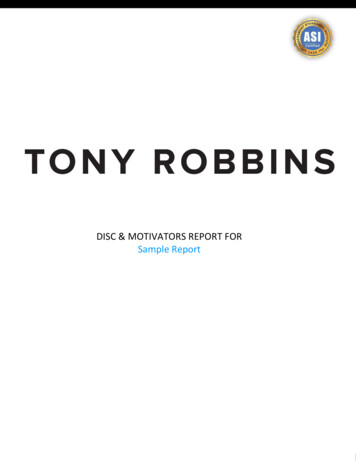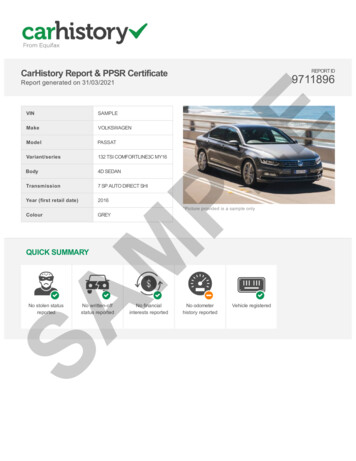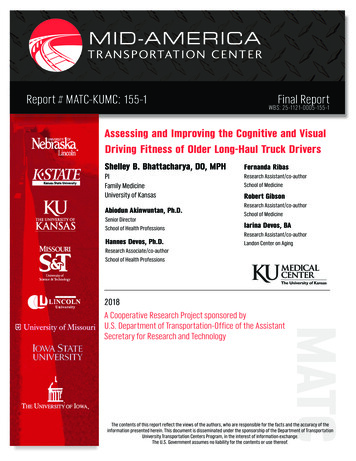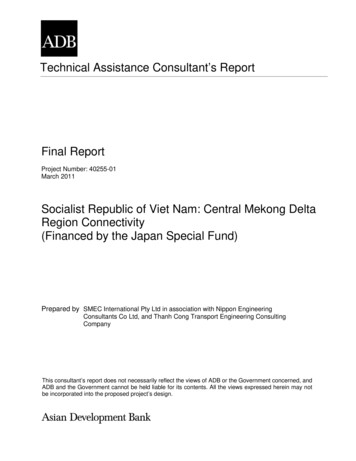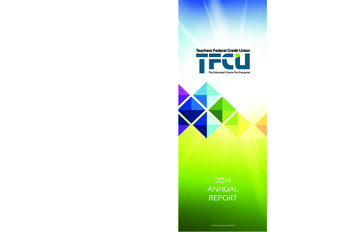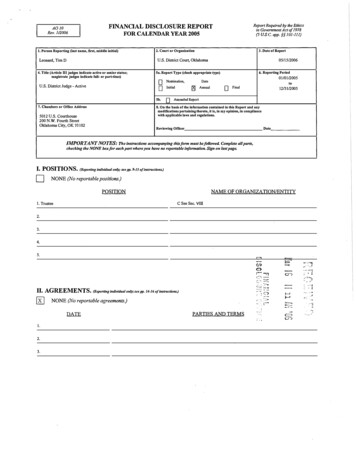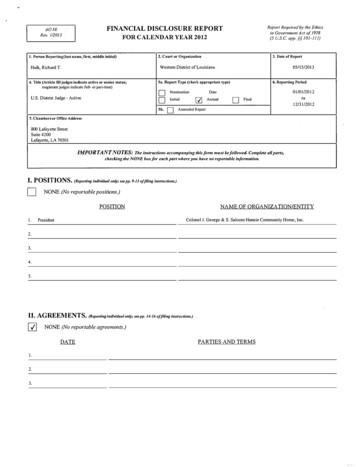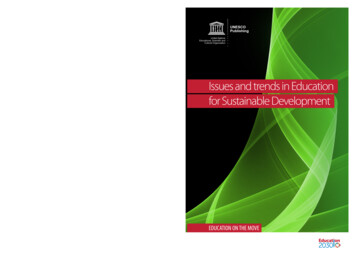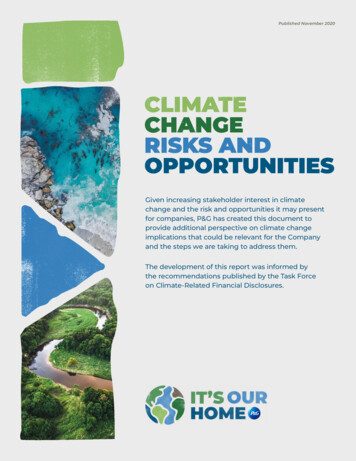
Transcription
Published November 2020Given increasing stakeholder interest in climatechange and the risk and opportunities it may presentfor companies, P&G has created this document toprovide additional perspective on climate changeimplications that could be relevant for the Companyand the steps we are taking to address them.The development of this report was informed bythe recommendations published by the Task Forceon Climate-Related Financial Disclosures.
GOVERNANCECLIMATE COUNCILChair: Vice President, Global SustainabilityThe following outlines thegovernance structure thatis currently in place forclimate-related issues.Participants: Climate and energy leaders from Manufacturing, R&D,Government Relations, and ProcurementPurpose:1 Monitor external trends and developments related toclimate change via engagement with outside organizations,conferences, and monitoring external publications2 Develop and maintain the Company’s overall Climate Strategy3 Monitor progress vs. climate related goals and ensureinterventions are implemented when neededMeets: QuarterlyGovernance Links: The Chair of Climate Council (Vice President, GlobalSustainability) is a member of the Sustainability Leadership Council andbrings relevant climate related issues to the Sustainability Leadership Councilfor awareness, strategic guidance, alignment to proposed actions and goals,as well as discussion of budget needs.SUSTAINABILITY LEADERSHIP COUNCILChair: Executive Sponsor for Sustainability(Currently CEO — Fabric & Home Care)Participants: CEO and Chairman of the Board, Chief R&D Officer, ChiefMarketing Officer, Chief Product Supply Officer, Chief Legal Officer, ChiefCommunications Officer, Chief Sustainability Officer, President of EuropeanSales & Marketing Organization, Vice President of SustainabilityIn addition to the structure to theright, P&G maintains an EnterpriseRisk Management (ERM) processto identify and assess risk factorsvia a multi-functional team ofexperienced resources. Findingsand recommendations madethrough the ERM process arereviewed with senior managers, inaddition to the Company’s Board ofDirectors and its Audit Committee,which has oversight responsibilities.Through the process, Companyleaders assess significant factorsthat may adversely affect ourbusiness, operations, financialposition or future financialperformance and includes anassessment of environmentalsustainability risk factors. The VicePresident of Sustainability andthe Chief Sustainability Officerparticipate in the ERM process toprovide perspective on relevantsustainability topics, includingclimate change.Purpose: Maintains overall oversight of sustainability efforts, includingclimate change. Includes monitoring progress vs. goals, providing strategicdirection, alignment to proposed program objectives and goals, discussionand allocation of resource needs.Meets: Quarterly. Climate Change is considered in the context of our overallsustainability efforts and agenda items are brought forward for discussionon an as-needed basis.Governance Links: The CEO and Chairman of the Board sits on the SLC andcan bring relevant climate-related items to the Company’s Board of Directorsand its Governance & Public Responsibility Committee, which has oversightof many of the Company’s Corporate Citizenship efforts, including climate.BOARD OF DIRECTORS(Governance & Public Responsibility Committee)The Governance & Public Responsibility Committee of the Board of Directorshas oversight for many of the Company’s Corporate Citizenship efforts,including Environmental Sustainability and related issues like Climate Change.Climate Change is not a standing agenda item at every Committee meeting,but relevant topics are brought forward for discussion on an as-needed basis.Members of this Committee are provided with periodic updates on progressof our Sustainability programs and goals, including efforts related to climatechange. The Chair of the Governance & Responsibility Committee thenupdates the full Board as needed.
PERSPECTIVEON CLIMATECHANGE RISKSIn the short to mid-term, the most relevant risks and impactsthat climate change presents for our Company are:1 Governments implementing policies/fees/taxes on carbon intensive energy ormaterials, which could result in higher costs for the Company and consumers.2 Increased severity/frequency of extreme weather events. Loss or impairment ofkey manufacturing sites, inability to procure sufficient raw materials, disruptionto transportation of raw materials or finished goods, etc. as result of an extremeweather event could disrupt our operations if the response to such an event isnot effectively managed and remedied.3 Chronic changes to precipitation/increasing water stress are relevant risks for ouroperations, supply chain, and consumer use of our products (e.g. sufficient waterfor laundry, dishwashing, showers, etc.).To better inform our identification of relevant risks and impacts,P&G’s Climate Council reviewed transitional and physical risksidentified in the Task Force for Climate Related DisclosureGuidelines and conducted a qualitative scenario analysis fortwo different scenarios:2⁰ ScenarioInformed by IPCC AR5 RCP 2.6, this scenario presumed CO2 emissions peak in 2020and decrease while global temperature increases by up to 2⁰ C. Under this scenario, weassumed regulatory and policy interventions by governments successfully controlledGHG emissions and that the impacts of physical risks (e.g. extreme weather) were notsignificant. In this scenario the primary impacts were higher costs for carbon intensivefuels, operations, and goods.4⁰ ScenarioInformed by IPCC AR5 RCP 8.5, this scenario presumed the carbon budget isexhausted by 2045 and global temperature rises by up to 4.8⁰C by 2100. Under thisscenario we assumed widespread policy failure to limit GHG emissions and lack ofinvestment in low carbon technologies. In this scenario, the physical risks from climatechange were much more relevant (e.g., frequency and intensity of extreme weatherevents, water scarcity and food shortages impacting the stable functioningof consumer markets and the ability of consumers to use/buy our products).The analysis of climate-related risks and impacts support the conclusion that, withoutany action, climate change could present risks to the business — primarily fromregulatory/policy actions that could increase the costs of energy and the potentialfor increased frequency/severity of extreme weather events disrupting operations orsupply chain. Scenario analysis also reinforced our belief that effective policy action willbe key to limiting global temperature increase to well below 2⁰C. We believe the mostlikely impact in the short to mid- term is policy action that places a price on carbon.Given the broad array of policy actions that could be implemented globally, it is difficultto assess with any certainty what the collective impacts of future policy actions couldbe. However, one theoretical approach to model potential impacts would be to place adollar/ton fee to P&G’s Scope 1 GHG emissions. For the fiscal year ending June 30, 2019,P&G reported 2,210,000 tons of Scope 1 emissions. Presuming that all of P&G’s Scope1 emissions were in scope for a global, uniform fee per ton of Scope 1 emissions, onecan model impacts by multiplying Scope 1 emissions by the projected fee ( /ton).
PERSPECTIVEON CLIMATECHANGE RISKSThis is a very conservative approach as it is unlikely that all Scope 1 emissions would bein scope but if one were to assume a carbon price of 40/ton it would yield a total fee of 88 million. While using different carbon prices in modeling such as this can providea range of potential impacts from policy action, we believe the comprehensive actionswe are already taking (see Strategy & Risk Management section below) will serve tolimit the impacts of short- and mid-term risks posed by climate change.Modeling of long-term impacts (e.g. 2100) is a helpful tool for scenario analysis. Forexample, under a 4⁰ scenario, long term impacts on food production, water scarcity,forced migrations, and flooding of coastal areas could impact the stable functioningof consumer markets and the ability of consumers to use or buy our products. Thesewould be broad, societal impacts and not unique to P&G. As noted below, effectivepolicy actions that limit GHG emissions and limit temperature increase to well below2⁰C serve to mitigate these risks, and we are supporting efforts to advance effectiveclimate policies.We will continue to monitor the latest science and data related to short-, mid-,and long-term impacts of climate change and adjust our strategy accordingly.
STRATEGY& RISKMANAGEMENTP&G’s Climate Council assesses climate-related risks and developsrisk mitigation strategies. We currently have a comprehensivestrategy in place that includes the following elements:Reducing our energy consumption and GHG emissionsBy reducing energy consumption and GHG emissions, we are not only doing our partto help reduce GHG emissions to the atmosphere but are also helping to mitigatepotential impacts from policy or regulatory actions that could put an increased priceon carbon emissions. The actions we are taking include:1 We are reducing scope 1 and 2 GHG emissions. We have a goal to reduce GHG by 50%on an absolute basis by 2030 (vs. 2010 baseline). This target has been approved by theScience Based Target Initiative as being consistent with well below 2⁰C.2 W e are increasing our use of renewable energy. Currently, we purchase 100%renewable electricity for operations in the United States, Canada, and WesternEurope. We have a goal to purchase 100% renewable electricity globally by 2030.3 We are reducing overall energy consumption. We have a goal to reduce energyby 20% per unit of production by 2020 (vs. 2010 baseline). To date, our energyconservation efforts have resulted in a savings of 500 million.4 I n addition to our goal to reduce Scope 1 and 2 emissions by 50%, P&G hascommitted to advance a portfolio of natural climate solutions that will deliver acarbon benefit equal to our projected cumulative GHG emissions for the periodof July 1, 2020 through June 30, 2030 — effectively making our operations carbonneutral for the decade. We took this action in large part in response to recent data,which reinforced the need for urgent action on climate change and identified thenext decade as a critical window to accelerate efforts on climate change.Helping Consumers reduce their GHG EmissionsTo understand which product categories had the highest GHG emissions duringthe consumer use phase, we conducted a comprehensive, lifecycle-based carbonfootprint analysis for our product portfolio. Based on this we know the greatest impactis associated with the use phase of our products that have traditionally used hotwater during the consumer use phase (laundry, dish, hair care). As a result, we haveput a sustained focus on cold water washing for laundry, developing detergents thatdeliver outstanding performance in cold water and launching education campaigns toencourage consumers to switch to cold. We have seen the percentage of loads donein low energy cycles increase from 38% to 70% since 2010. Given the performanceof our detergents in cold water, we believe this represents an opportunity to bettermeet consumer needs. The performance of our HE detergents also helps optimizeperformance of HE machines, helping consumers realize the savings in both energyand water that HE machines can deliver. Similarly, our auto-dish business is helpingconsumers understand that depending on the size of the load, it can be more resourceefficient to use an automatic dishwashing machine vs. washing by hand (CascadeYouTube Video).Policy EngagementExisting carbon pricing schemes have had relatively little impact on our operationsas most of our operations are not energy intensive. The U.S. represents one marketthat has not implemented a national policy on carbon pricing. To help ensure thatany future US Policy efforts provide business the needed certainty, predictability, andtransparency, P&G joined the Climate Leadership Council (CLC). CLC is an organizationthat advocates for a Carbon Dividends Program in the US as the best policy mechanismto drive greenhouse gas emissions reductions commensurate with a 2⁰ C target.
STRATEGY& RISKMANAGEMENTWe believe that if the US moves forward with a national carbon pricing policy effort,this type of an approach would provide the greatest transparency and certainty forbusiness. P&G also works with our various business trade associations to help educateand enroll them in taking proactive steps to address climate change.Business Continuity PlanningExtreme weather events represent a potential risk. Loss or impairment of keymanufacturing sites, inability to procure sufficient raw materials, disruption totransportation of raw materials or finished goods, etc. could disrupt our operations ifthey are not effectively managed and remedied. We have over 100 sites globally anda broad supplier network. This provides some level of flexibility to adjust productionand sourcing. In addition, each site has a business continuity plan, which is regularlyreviewed and updated. These plans include considerations for disruptions caused byextreme weather events.Proactively assessing and mitigating water related risksChronic changes to precipitation/increasing water stress are relevant risks forour operations, supply chain, and our consumer markets (e.g. water for laundry,dishwashing, showers, etc.). We are advancing the following efforts to managerelevant water-related risks: All manufacturing sites are covered by our water risk assessment process. This is atiered risk assessment. We have screened all sites and identified sites that fall intoTier III (sites most at risk for water stress). These sites will need to develop site-specificwater stewardship plans to mitigate potential risks. We have conducted risk assessment for key consumer markets and combined withdata on manufacturing sites and supplier locations, we are identifying priority basinsaround the world where we will implement collaborative efforts to improve watersecurity in those regions. We have a 2020 goal to provide 1 billion consumers access to water efficient products.These are products that offer a significant reduction of water use during theconsumer use phase. By providing access to WEPs, we can better serve consumerneeds in areas experiencing water stress.METRICSP&G has established the following goals and metrics related to climatechange. We report progress publicly each year as part of our annualcitizenship report: 30% absolute reduction in Scope1 and 2 GHG emissions by 2020(baseline 2010) 2 0% reduction in energyconsumption, per unit ofproduction, by 2020 (baseline 2010) 50% absolute reduction in Scope1 and 2 GHG emissions by 2030(baseline 2010) 20% reduction in truck km perunit of production by 2020(baseline 2010) Purchase 100% renewableelectricity by 2030 7 0% of machine washing loadsdone in low energy cycles (by 2020)In addition to reporting progress vs. these goals, P&G also publishes thefollowing data on an annual basis in our Citizenship Report (available atwww.pg.com): Energy consumption (gigajoules), Scope 1 GHG emissions(metric tons), Scope 2 GHG emissions (metric tons), and estimates of relevantScope 3 GHG emission categories (metric tons). We have had 3rd partyassurance of our GHG emissions inventory for Fiscal Years 17/18, 18/19 andintend to maintain that practice going forward.
Existing carbon pricing schemes have had relatively little impact on our operations as most of our operations are not energy intensive. The U.S. represents one market that has not implemented a national policy on carbon pricing. To help ensure that any future US Policy efforts p
